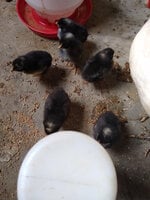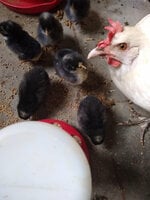Pretty Birds
Crowing
My broody Austra White pullet hatched six chicks! The father is a White Plymouth Rock, and the mothers are/could be Cuckoo Marans, Speckled Sussexs, Easter Eggers, a Delaware, a Buff Orpington, a Barred Plymouth Rock, or Golden Comets. I know one chick is half Maran, because the dark brown egg hatched. I also know one is an Easter Egger because the green/blue egg hatched, and one of the chicks has a beard and pea comb.
I was expecting a bunch of different colored chicks, but they are all black and yellow! They have different amounts of yellow; some are half yellow, and some just have yellow on the top of their heads, and some are in between. I know it must be because of the father, but how can that be if he is white?


I was expecting a bunch of different colored chicks, but they are all black and yellow! They have different amounts of yellow; some are half yellow, and some just have yellow on the top of their heads, and some are in between. I know it must be because of the father, but how can that be if he is white?





